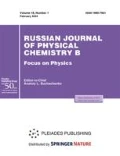Abstract
The antiradical properties and biological activity of natural polyphenol—resveratrol—are studied. The chemiluminescence method recorded high values of the antiradical activity of this drug. Using the model system, it is shown that the drug in the concentration range of 10–5 to 10–12 M prevented the activation of lipid peroxidation (LPO) in the mitochondrial membranes of pea seedlings, which could indicate the presence of antistress properties in this preparation, which are studied under conditions of water deficiency, which causes LPO and leads to mitochondrial swelling. Resveratrol seed treatment (3 × 10–5 M) under these conditions leads to a decrease in the number of swollen mitochondria and the appearance of small mitochondria, which, perhaps, is a sign of the activation of mitochondrial biogenesis. Resveratrol, which prevents LPO, helps maintain the functional state of mitochondria and activates the energy metabolism by increasing their number, which is reflected in the physiological parameters: the drug prevents a decrease in the growth rate of pea seedlings in conditions of water deficiency. Based on the data obtained, it is assumed that the drug has antistress properties in the concentration range in which it exhibits an antioxidant effect.






Similar content being viewed by others
REFERENCES
M. J. Takaoka, J. Faculty. Sci. 1 (3), 1 (1940).
W. Dercks and L. L. Creasy, Physiol. Mol. Plant Pathol. 34, 203 (1989).
P. Jeandet, A. C. Douillet-Breuil, R. Bessis, et al., J. Agricul. Food Chem. 50, 2731 (2002).
M. Adrian, P. Jeandet, J. Veneau, L. A. Weston, and R. Bessis, J. Chem. Ecol. 23, 1689 (1997).
J. A. Baur and D. A. Sinclair, Nature (London, U.K.) 425, 191 (2003).
M. Athar, J. H. Back, L. Kopelovich, et al., Arch. Biochem. Biophys. 486, 95 (2009).
H. S. Mahal and T. Mukherjee, Res. Chem. Intermed. 32, 59 (2006).
W. R. Leifert and M. Y. Abeywardena, Nutr. Res. 28, 842 (2008).
V. Roman, C. Billard, C. Kern, et al., Br. J. Haematol. 117, 842 (2002).
E. Wenzel and V. Somoza, Mol. Nutrit. Food Res. 49, 472 (2005).
X. Vitrac, A. Desmouliére, B. Brouillaud, et al., Life Sci. 72, 2219 (2003).
N. L. Tailor, D. A. Day, and A. H. Millar, J. Exp. Bot. 55 (394), 1 (2003).
C. Moreira, A. M. Silva, M. S. Santos, and V. A. Sardão, Food Chem. Toxicol. 53, 18 (2013).
A. Ahmad, F. A. Syed, S. Singh, and S. M. Hadi, Toxicol. Lett. 159, 1 (2005).
N. M. Emanuel’ and D. Gal, Oxidation of Ethylbenzene: A Model Reaction (Nauka, Moscow, 1984) [in Russian].
V. Ya. Shlyapintokh, O. N. Karpukhin, L. M. Postnikov, et al., Chemiluminescence Methods of Investigation of Slow Chemical Processes (Nauka, Moscow, 1966) [in Russian].
I. F. Rusina, O. N. Karpukhin, and O. T. Kasaikina, Russ. J. Phys. Chem. B 7, 463 (2013).
Organic Solvents. Physical Properties and Methods of Purification, Ed. by A. Weissberger, E. Proskauer, J. Riddik, and E. Toops (Interscience, New York, 1955).
V. A. Belyakov, R. F. Vasil’ev, and G. F. Fedorova, Kinet. Catal. 45, 329 (2004).
V. N. Popov, E. K. Ruge, and A. A. Starkov, Biochemistry (Moscow) 68, 747 (2003).
B. I. Fletcher, C. D. Dillard, and A. L. Tappel, Anal. Biochem. 52, 1 (1973).
D. B. Zorov, N. K. Isaev, E. Yu. Plotnikov, L. D. Zorova, E. V. Stelmashook, A. K. Vasileva, A. A. Arkhangelskaya, and T. G. Khrjapenkova, Biochemistry (Moscow) 72, 1115 (2007).
I. Zhigacheva, I. Generozova, A. Shugaev, et al., Ann. Res. Rev. Biol. 5, 85 (2015).
A. V. Khvan, in Biology Issues (Blagoveshchensk, 1969), p. 104 [in Russian].
N. A. Shugaeva, E. I. Vyskrebentseva, S. O. Orekhova, and A. G. Shugaev, Fiziol. Rast. 54, 373 (2007).
S. M. Claypool, J. M. McCaffery, and C. M. Koehler, J. Cell Biol. 174, 379 (2006).
V. I. Binyukov, E. M. Mil’, I. V. Zhigacheva, A. A. Albantova, I. P. Generozova, A. G. Shugaev, S. G. Fattakhov, and A. I. Konovalov, Dokl. Biochem. Biophys. 446, 220 (2012).
M. R. De-Oliveira, S. F. Nabavi, A. Manay, et al., Biochem. Biophys. Acta 1860, 727 (2016).
L. Zhang, Yinshu Li, Da-Xing, and Caiji Gao, J. Exp. Bot. 60, 2073 (2009).
I. Scott and D. C. Logan, New Phytol. 177, 90 (2008).
D. S. Selote, S. Bharti, and R. Khanna-Chopra, Biochem. Biophys. Res. Commun. 314, 724 (2004).
G. Miller, N. Suzuki, S. Ciftci-Yilmaz, and R. Mittler, Plant, Cell Environ. 33, 453 (2010).
I. P. Generozova and A. G. Shugaev, Fiziol. Rast. 59, 262 (2012).
R. Zini, C. Morin, A. Bertelli, et al., Drugs Experimen. Clin. Res. 25, 87 (1999).
J. R. Jackson, M. J. Ryan, Y. Hao, and S. E. Alway, Am. J. Physiol. Regulat. Integr. Comp. Physiol. 299, R1572 (2010).
A. Csiszar, N. Labinskyy, A. Podlutsky, et al., Am. J. Physiol. Heart Circ. Physiol. 294, H2721 (2008).
Z. Ungvari, W. E. Sonntag, R. de Cabo, J. A. Baur, and A. Csisrar, Exer. Sport Sci. Rev. 39, 128 (2011).
N. M. Emanuel’, E. T. Denisov, and Z. K. Maizus, Chain Reactions of Liquid-Phase Oxidation of Hydrocarbons (Nauka, Moscow, 1965) [in Russian].
N. A. Azatyan, G. V. Karpukhina, I. S. Belostotskaya, and N. M. Komissarova, Neftekhimiya 33, 435 (1973).
Funding
This work was carried out as part of state task 0082-2018-0006 (nos. AAAA-A18-118020890097-1, 0084-2014-0004) of the Federal Agency for Scientific Organizations. Registration no. 01201-253-310 at the Center for Information Technologies and Systems of Executive Authorities.
Author information
Authors and Affiliations
Corresponding author
Rights and permissions
About this article
Cite this article
Zhigacheva, I.V., Binyukov, V.I., Rusina, I.F. et al. Antioxidant and Antiradical Properties of Resveratrol and Its Antistress Activity. Russ. J. Phys. Chem. B 14, 678–684 (2020). https://doi.org/10.1134/S1990793120040120
Received:
Revised:
Accepted:
Published:
Issue Date:
DOI: https://doi.org/10.1134/S1990793120040120


